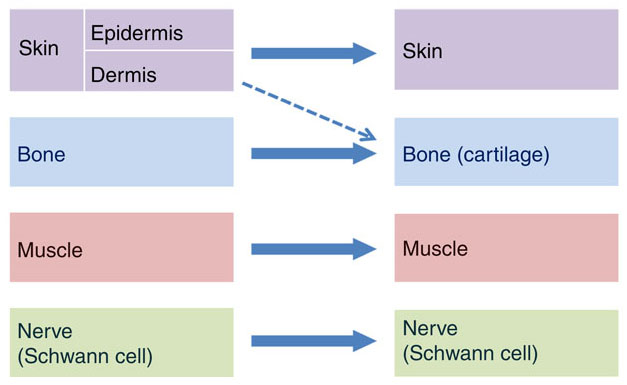Research Abstract
イモリの肢の筋再生では幹細胞型から脱分化型への切り替えが発生段階により調節される
A developmentally regulated switch from stem cells to dedifferentiation for limb muscle regeneration in newts
2016年3月30日 Nature Communications 7 : 11069 doi: 10.1038/ncomms11069

イモリは、有尾両生類の1種であり、生涯にわたって肢を繰り返し再生できるが、他の両生類では変態後には肢を再生する能力が低下あるいは喪失する。このようなイモリの卓越した再生能力が、幼生期の再生を制御する戦略を基盤とするものであるのか、それとも変態後のイモリが生み出した新規の戦略を基盤とするものであるのかは解明されていない。今回我々は、イモリが変態して成長するのに伴い、肢再生の細胞機構が幹/前駆細胞を基盤とする機構(幼生モード)から脱分化を基盤とする機構(成体モード)に切り替わることを報告する。幼生のイモリは再生された肢では衛星細胞のような幹/前駆細胞を用いて新しい筋を作り出すが、変態後のイモリは切断部の筋繊維細胞を動員して新しい筋を作り出す。我々は、イモリが変態後の肢の再生能を保証する新しい戦略を進化させたと結論する。
Corresponding Authors
The newt, a urodele amphibian, is able to repeatedly regenerate its limbs throughout its lifespan, whereas other amphibians deteriorate or lose their ability to regenerate limbs after metamorphosis. It remains to be determined whether such an exceptional ability of the newt is either attributed to a strategy, which controls regeneration in larvae, or on a novel one invented by the newt after metamorphosis. Here we report that the newt switches the cellular mechanism for limb regeneration from a stem/progenitor-based mechanism (larval mode) to a dedifferentiation-based one (adult mode) as it transits beyond metamorphosis. We demonstrate that larval newts use stem/progenitor cells such as satellite cells for new muscle in a regenerated limb, whereas metamorphosed newts recruit muscle fibre cells in the stump for the same purpose. We conclude that the newt has evolved novel strategies to secure its regenerative ability of the limbs after metamorphosis.

